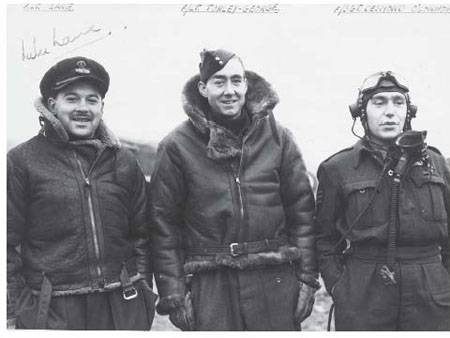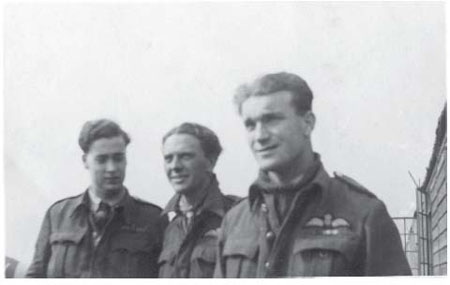A Very Unusual Air War (16 page)
Read A Very Unusual Air War Online
Authors: Gill Griffin

23
February
: This was an early type of GCA (Ground Controlled Approach) to assist landing in bad weather conditions.
24 February
: My elder brother, Leslie, 13 years my senior, also volunteered in late 1941 for service in the RAF. Having been closely involved in our father’s garage repair and car hire service business at Waddesdon, Leslie was an experienced driver and mechanic. This would normally have seen him, by Murphy’s Law, become a cook but miracles do happen and he served as a driver in the MT (Motor Transport) section. All his life Les had suffered from severe asthma and we couldn’t believe it when, in February 1942, he was posted to India. All efforts to get the posting cancelled failed. So on this day, I obtained permission to fly to Bircham Newton in order to pay him a farewell visit. There I was informed that he was at nearby Langham and, having flown there, I was directed to the MT drivers’ duty room. There were several aircraftsmen sitting around the room, all of whom stood to attention when I, a Pilot Officer, entered. Leslie was sitting on the far side, deeply engrossed in a magazine and when I walked over to stand before him, he still remained in his seat. So, very sharply, I shouted ‘Thorne!’ This achieved the required response; he sprang to attention, looked me straight in the eye and greeted me with ‘You silly bugger!’ There was a shocked silence from the other occupants until they realised that I was Leslie’s younger brother. We were able to have a short chat, then he drove me out to my aeroplane for our farewell but refused the offer of a fun flight in the Maggie; he did not trust me not to subject him to a few aerobatics. We were not to meet again for four years, when he returned home in 1946.
28 February
: This was, in fact, intended to provide cover to what was called a ‘biting’ operation returning from Le Havre. As part of the circus, shortly after take-off my hood jammed in the half open position and I was obliged to return to base. When the fault had been corrected it was too late to catch the other boys.
I was confirmed as the senior NCO pilot in ‘A’ Flight so no more flying as arse-end Charlie. I would continue as a sub-section leader but, more important, I could now deputise for a flight commander and lead a flight. Also, orders to the pilots of ‘A’ Flight were passed through me.
| Summary for:- February 1942 | Spitfire | 4–25 |
| Unit:- 602 Squadron | Magister | 5–20 |
| Date:- 1/3/42 | | |
| Signature:- H.L. Thorne | | |
| Total time on Spitfire | 200 hours 45minutes |
| Operational hours to date | 69 hours 40 minutes |
| John B. Niven P/O pp F/Lt | B.P. Finucane S/Ldr |
| For O/C. A Flight | O/C 602 Squadron |
| [A written note] | |
| LINK TRAINER FOR MONTH | F.V. Beamish G/Cpt. |
| | C/O of RAF Station Kenley |
This was a sharp reminder from the station commander. Link trainer or else! This was a dig from the boss; however, there was no entry to add for the Link trainer as I, in common with the other pilots, had not done any. There was no Link at Redhill and we could not be bothered to go back to Kenley – although we did go for sessions in the UVR room!

Len Thorne giving instruction in aero engines to a member of Southwark ATC in February 1942.

Southwark ATC listening to a lecture on combat manoeuvres given by Len Thorne on the same occasion.

F/Lt
Roy ‘Lulu’ Lane, F/Lt Turley-George and F/Lt Desmond O’Connor. F/Lts Lane and Turley-George volunteered to be catapulted off merchant ships. This was considered to be a suicide job but both survived. Dessie O’Connor was killed in March 1942.

602 Squadron, March 1942. Sgt Paul Green, Sgt Sanderson (RAAF), S/Ldr Brendan ‘Paddy’ Finucane.
| YEAR | 1940 | AIRCRAFT | Pilot or 1st Pilot | 2nd Pilot, Pupil or Pass. | DUTY (Including Results and Remarks) | Flying Time | Passenger | ||
| MONTH | DATE | Type | No. | Dual | Solo | ||||
| March | 1st | Spitfire | AD536 | Self | | Cloud flying and formation | | –40 | |
| | | Spitfire | AD536 | Self | | Cloud flying and formation | | 1–00 | |
| | 3rd | Spitfire | AD536 | Self | | Sweep to Le Touquet and Calais | | 1–45 | |
| | 5th | Spitfire | AD536 | Self | | Redhill to Kenley | | –20 | |
| 8th | Spitfire | AD536 | Self | | Sweep to Le Touquet area | | 1–20 | | |
| | | Spitfire | W3638 | Self | | Bomber escort to Abbeville | | 1–25 | |
| | 9th | Spitfire | AD536 | Self | | Air test | | 1–10 | |
| | 12th | Spitfire | P8799 | Self | | Convoy patrol | | 1–50 | |
| | 13th | Spitfire | W3898 | Self | | Drogue towing | | –45 | |
| | | Spitfire | W3756 | Self | | Practice formation | | –45 | |
| | | Spitfire | P8799 | Self | | Cricus to Hazebrouke | | 1–45 | |
| | 14th | Spitfire | AB794 | Self | | Circus to Le Havre | | 1–30 | |
| | 19th | Spitfire | P8799 | Self | | Formation and weaving practice | | 1–05 | |
| | 26th | Spitfire | BM186 | Self | | Air test and aerobatics | | –45 | |
| | 27th | Spitfire | B7186 | Self | | Beat up Deal golf course | | 1–20 | |
| | | Spitfire | P8799 | Self | | Beat up Deal golf course | | 1–05 | |
| | | Spitfire | P8799 | Self | | Fighter sweep | | –30 | |
| | 28th | Spitfire | BM142 | Self | | Cine gun and formation | | 1–00 | |
| | | Spitfire | BM187 | Self | | Fighter sweep | | 1–35 | |
| | | Spitfire | BM187 | Self | | Channel search for Group Captain F.V. Beamish | | 1–10 | |
| | 29th | Spitfire | BM156 | Self | | At first light we resumed the search for the Group Captain | | 2–00 | |
| | | Spitfire | BM142 | Self | | To Duxford | | –45 | |
| | | Spitfire | BM142 | Self | | Army co-op beat up | | 1–20 | |
| | Spitfire | BM142 | Self | | Return to Kenley | | –40 | | |
| | 31st | | | | | GRAND TOTAL TO DATE 373 hours 35 minutes | 3–30 | 8–25 | |
| | | | | | | | 55–25 | 306–15 | 7–40 |
3 March
: Although this was a very shallow penetration into enemy territory we remained in the area for some time, receiving a pretty fierce reception from flak, particularly from the Calais area, but no opposition from fighters. I was pleased that, two days later, we returned to the comforts of Kenley.
9 March
: The rest of the Squadron did a sweep to Betune. My friend through most of my training time, particularly at Hullavington and Hawarden, Flight Sergeant Desmond (Dessie) O’Connor, failed to return and it was later confirmed that he was killed. Desmond was a quiet, likeable North-country lad and, although according to the author of
Lions Rampant
, the Squadron history, ‘he was not outstanding’ the gentleman should note that Dessie did the operations to the best of his ability and gave his life in the end. It was my first loss of a close friend and I missed him badly.
13 March
: I am puzzled by this first entry as, to the best of my memory, no Spitfire was ever equipped with drogue-towing facilities. The entry should probably have read that we did air firing against a drogue target towed by another aircraft such as the Hawker Henley.
